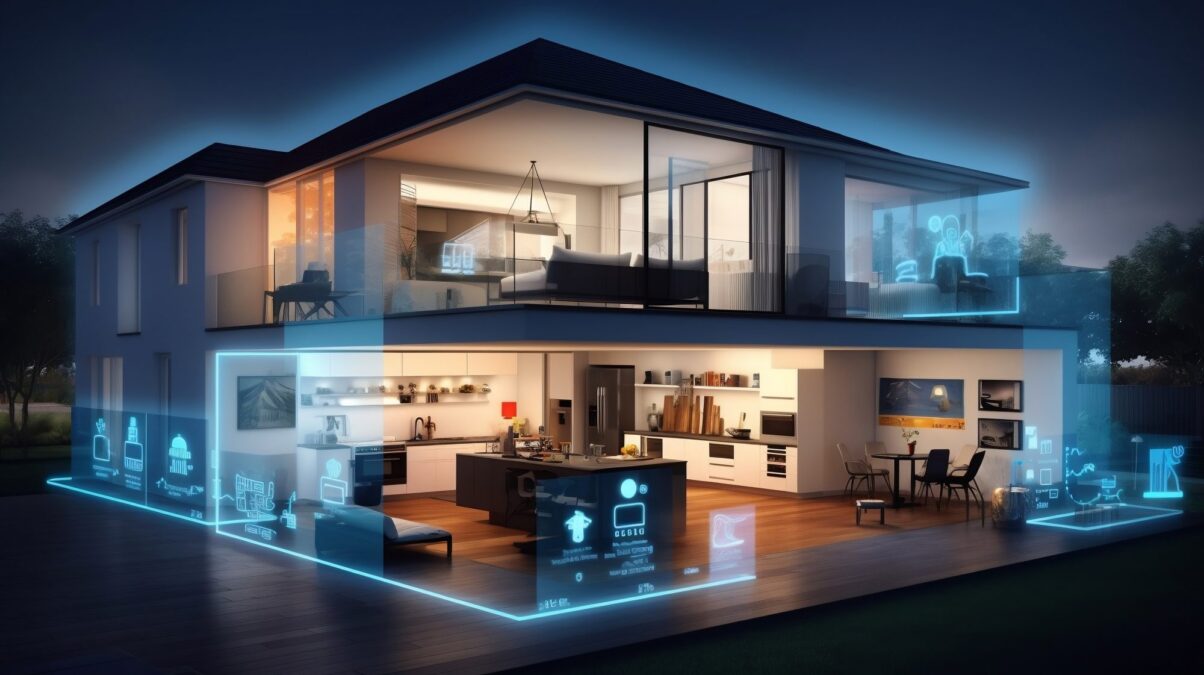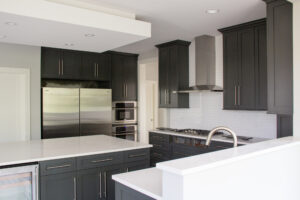The Rise of Smart Homes: Transforming the Way We Live

It was a typical weekday morning when Sarah’s alarm gently faded in, synchronized perfectly with the slow rise of the blinds to let in the morning sunlight. Her coffee machine had already brewed her favorite roast, and as she stepped out of bed, the floor warmed beneath her feet, thanks to the heated floors she had programmed the night before. On her way out the door, she simply said, “Lock the house,” her home security system armed itself while the lights dimmed, the thermostat adjusted to an energy-saving mode, and her robot vacuum quietly began cleaning. Sarah didn’t have to lift a finger — her smart home cared for everything. Like millions of others embracing technology, Sarah’s bright house was more than just a place to live. It had become an efficient, convenient, and seamlessly integrated extension of her life.
What is a Smart House?
An intelligent house, also known as a smart home, refers to a residence equipped with technology that allows for the automation of various household systems, including lighting, heating, security, entertainment, and even appliances. These systems are often controlled remotely via smartphone apps, voice assistants like Amazon’s Alexa or Google Assistant, or through centralized control hubs.
The rise of smart home technology has been driven by the increasing availability of affordable, connected devices and the growing demand for convenience, energy efficiency, and security. From smart thermostats that learn your temperature preferences to advanced security systems that provide real-time video surveillance, smart homes offer a wide range of customizable features.
A Growing Market: The Rise of Smart Home Technology
The market for smart home technology has exploded over the last decade. According to a report by Statista, the global smart home market is projected to grow from $79.7 billion in 2020 to $313.95 billion by 2026, reflecting a compound annual growth rate (CAGR) of 25%. Technological advances, increased consumer interest, and a shift toward sustainability drive this rapid growth.
In the United States alone, Statista reports that the smart home market will reach an estimated $40.9 billion by the end of 2024, with nearly 69% of households expected to have at least one smart device by that time. Smart speakers, bright lighting, smart locks, and thermostats have become household staples. The most popular category is smart speakers, with Parks Associates reporting that 54% of U.S. households with broadband own a smart speaker like Amazon Echo or Google Nest.
The COVID-19 pandemic also fueled the adoption of smart home technology, as more people spent time working, learning, and entertaining themselves at home. Gartner found that in 2020, smart home devices saw a 12.2% increase in sales as consumers sought to upgrade their home environments to make them more comfortable, efficient, and secure.
The Smart House Ecosystem: Popular Devices and Technologies
A smart home consists of various interconnected devices that can communicate with each other, either through a central hub or directly via Wi-Fi or Bluetooth. Here are some of the most popular categories of smart home devices and how they enhance daily life:
- Smart Speakers and Voice Assistants
Smart speakers like Amazon Echo, Google Nest, and Apple HomePod are the central hub for many smart homes. Powered by voice assistants like Alexa, Google Assistant, or Siri, these devices allow users to control other smart home gadgets with simple voice commands. Whether turning on the lights, playing music, or adjusting the thermostat, voice assistants have become a key feature of modern smart homes.
According to Voicebot.ai, as of 2023, there are approximately 135 million smart speakers in U.S. households, with Amazon’s Alexa holding a dominant 63% market share, followed by Google Assistant at 31%.
- Smart Lighting
Intelligent lighting systems like Philips Hue or LIFX allow users to control their lights remotely through smartphone apps or voice commands. These systems offer dimming, color changes, and scheduling, making setting the perfect ambiance easy or improving energy efficiency by turning off lights when they’re not needed.
The smart lighting market is expected to grow from $11.9 billion in 2023 to $27.7 billion by 2028, with energy-conscious consumers increasingly adopting these systems to lower electricity bills and reduce their carbon footprint (MarketsandMarkets).
- Smart Thermostats
Devices like the Google Nest Learning Thermostat or Ecobee are designed to optimize home energy use by learning users’ habits and adjusting the temperature accordingly. They can be controlled remotely, set schedules, and even provide detailed reports on energy usage. According to Energy Star, by using a smart thermostat, homeowners can save an average of 10-15% on heating and cooling costs.
In the U.S., the market for smart thermostats has grown significantly. As of 2023, approximately 33% of U.S. households with broadband have adopted a smart thermostat, according to Parks Associates.
- Smart Security Systems
Smart technology has revolutionized home security, with companies like Ring, Nest, and Arlo offering advanced security cameras, doorbell cameras, motion detectors, and smart locks. These devices allow homeowners to monitor their property in real-time from their smartphones, receive instant alerts, and even communicate with visitors remotely.
According to a SafeWise survey, over 47% of U.S. households use some form of smart security device, with video doorbells and smart cameras being the most popular options.
- Smart Appliances
From refrigerators that can order groceries to washing machines you can control from your phone, smart appliances are rapidly becoming standard in modern homes. Brands like Samsung, LG, and Whirlpool have introduced bright kitchen and laundry appliances that make household chores more efficient and convenient.
According to Allied Market Research, the global smart appliance market is projected to grow from $32.2 billion in 2021 to $76.4 billion by 2027. This growth reflects the growing consumer interest in appliances that can integrate into the larger smart home ecosystem.
Benefits of a Smart House
The increasing adoption of smart homes isn’t just about embracing the latest technology; it’s also about improving the quality of life in several key areas:
- Convenience
Smart home devices simplify everyday tasks. Whether you turn off all the lights with one command before leaving the house, set the thermostat from work, or use voice commands to create reminders, smart homes offer unparalleled convenience.
- Energy Efficiency
Smart homes help reduce energy consumption by allowing users to monitor and control their systems more precisely. Devices like smart thermostats and energy-efficient lighting systems can lead to significant savings on electricity and heating bills. In fact, according to Smart Energy International, homes equipped with smart technology can reduce energy consumption by up to 30%.
- Home Security
Smart security systems enhance safety by allowing users to monitor their homes 24/7. Video doorbells, smart locks, and security cameras offer peace of mind by keeping homeowners connected to their property no matter where they are.
- Health and Wellness
Smart devices like air purifiers, sleep trackers, and fitness monitors can help improve health and wellness. For example, intelligent air purifiers like Dyson Pure Cool or Molekule monitor air quality and automatically adjust settings to remove air pollutants, allergens, and dust. Intelligent beds and fitness trackers can monitor sleep patterns and physical activity, helping users stay healthy and informed.
Challenges and Considerations
While smart homes offer many benefits, they aren’t without challenges. One of the primary concerns is privacy and data security. Smart devices are often connected to the internet and collect data on user behavior. A study by Consumer Reports found that 59% of smart home device owners were concerned about their privacy, particularly with devices like smart speakers and security cameras.
Additionally, compatibility between devices can be an issue. Not all smart devices communicate seamlessly, especially from different manufacturers. While platforms like Amazon Alexa and Google Assistant offer broad compatibility, some products may require specific apps or hubs, complicating the setup process.
Finally, the cost of smart home technology can be a barrier for some consumers. While prices have come down over time, building a fully automated smart home can still be a significant investment, with the average household spending anywhere from $1,000 to $3,000 on smart devices, according to PCMag.
The Future of Smart Homes
As technology continues to evolve, the possibilities for smart homes are nearly endless. Experts predict that artificial intelligence (AI) will play an even more significant role in future smart homes, with devices learning user preferences and making predictive adjustments without input. Additionally, integrating 5G technology will allow smart devices to communicate faster and more efficiently, improving the user experience.
According to Grand View Research, the global smart home market is expected to reach $537.6 billion by 2030, with advancements in AI, machine learning, and 5G driving the next wave of smart home innovation.
Conclusion
Smart homes are revolutionizing the way we live, offering convenience, energy efficiency, and security that were once the stuff of science fiction. With millions of people embracing the technology and the market expanding rapidly, it’s clear that the future of living is bright. Whether it’s controlling the temperature, monitoring home security, or simply asking Alexa to play your favorite song, smart homes are making life easier, more efficient, and more connected than ever.





